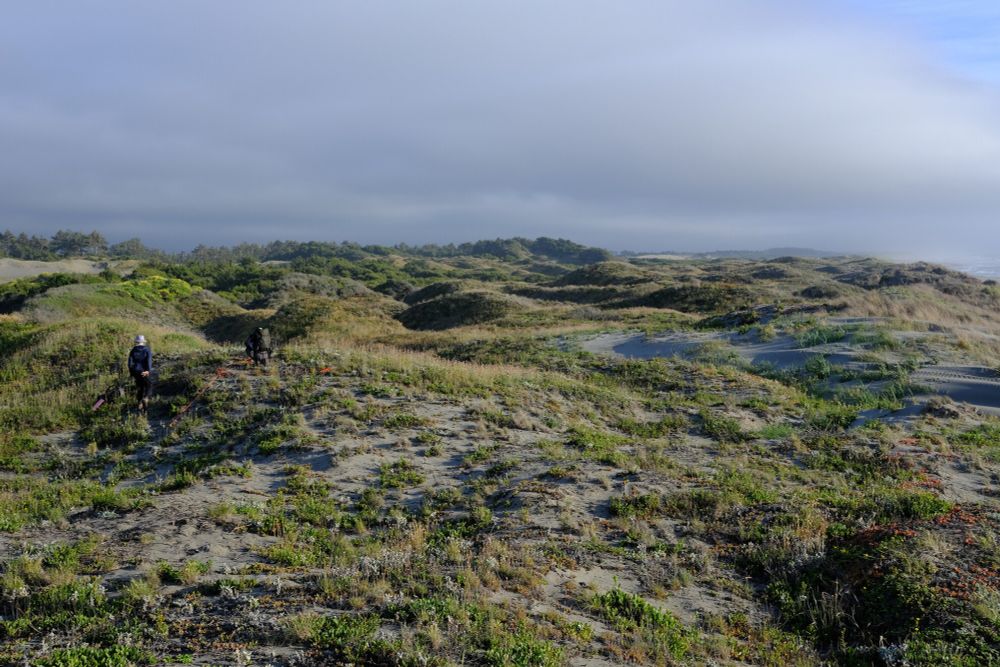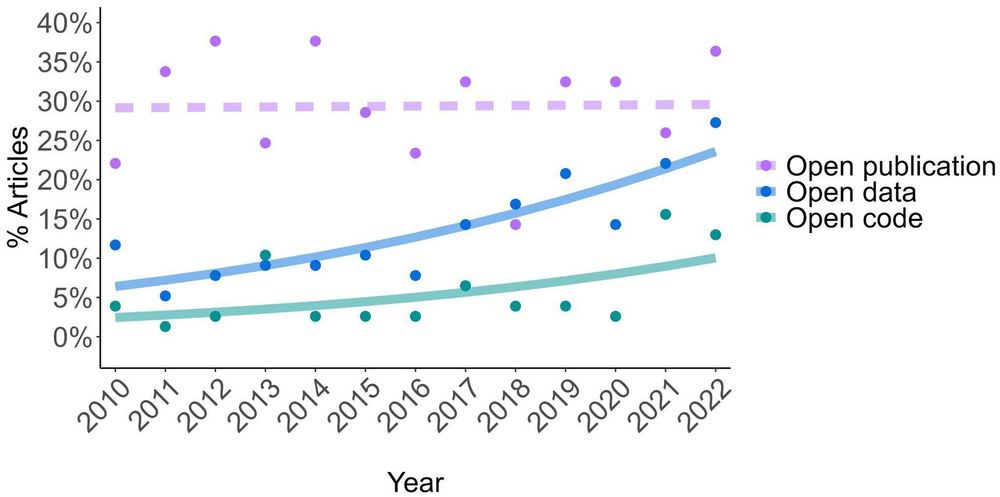Great to meet you too, looking forward to chatting more! Safe travels back!
15.08.2025 16:04 — 👍 0 🔁 0 💬 0 📌 0
Congrats Jalene!! 🌲
15.08.2025 12:56 — 👍 1 🔁 0 💬 1 📌 0
I'm very proud to receive the 2025 Robert P. McIntosh Award from the @ecologicalsociety.bsky.social Vegetation Section at #ESA2025 with an amazing group of colleagues, for our paper on Community #MastSeeding. 🥳
Paper: onlinelibrary.wiley.com/doi/abs/10.1...
Award info: esa.org/vegetation/a...
14.08.2025 21:17 — 👍 47 🔁 8 💬 11 📌 0
#ESA2025! We would love to fill this up with signatures. Let's show support to the folks at NSF. Find it Wednesday morning at the spot below, and it'll be at the NSF funding session at 10-11:30am.
13.08.2025 00:32 — 👍 9 🔁 4 💬 0 📌 0


If you’re at ESA @ecologicalsociety.bsky.social 2025 in Baltimore, come check out my talk about population dynamics and the geographic range limits of a coastal dune plant! Tomorrow (Wednesday) at 8:45am in Hilton 5!
12.08.2025 13:39 — 👍 6 🔁 2 💬 0 📌 0

OOS 05 - Beyond Budburst–Connecting Phenological Transitions Among Tissues and Times in Woody Plants
Monday, August 11 3:30 PM – 5:00 PM EDT
Hilton Key 8
Session Type: Organized Oral Session

Presentations
OOS 05-01 - Seasonal underground phenology of ectomycorrhizal fungi varies by group and host tree traits
Monday, August 11, 2025 at 3:30 PM – 3:45 PM EDT
Presenting Author - Nicholas Medina
OOS 05-02 - Genetic structure across a poplar hybrid zone will cause variation in phenological responses to a warming climate
Monday, August 11, 2025 at 3:45 PM – 4:00 PM EDT
Presenting Author - Alayna Mead

OOS 05-03 - Aridity decouples carbon assimilation and growth in temperate deciduous oaks
Monday, August 11, 2025 at 4:00 PM – 4:15 PM EDT
Presenting Author - Mukund Palat Rao
OOS 05-04 - Cold hardiness connects bud development in the summer and fall with budbreak in the spring
Monday, August 11, 2025 at 4:15 PM – 4:30 PM EDT
Presenting Author - Al Kovaleski

OOS 05-05 - Phenology of tree reproduction; environmental cues and vetos
Monday, August 11, 2025 at 4:30 PM – 4:45 PM EDT
Presenting Author - Jalene LaMontagne
OOS 05-06 - Macrophenology: expanding the taxonomic and geographic scope of phenology research using volunteer- and network-collected observations
Monday, August 11, 2025 at 4:45 PM – 5:00 PM EDT
Presenting Author - Amanda Gallinat
I'm giving a talk on Monday at #ESA2025, in the OOS about #phenology "Beyond Budburst" (3:30-5:00pm), organized by Luke McCormack & Christy Rollinson. There's a great list of speakers. I'm presenting at 4:30pm.
Room: Hilton Key 8
🚨 NOTE: Individual talk times within the session were updated today!
10.08.2025 18:31 — 👍 23 🔁 9 💬 1 📌 0
This map ⬇️ is from a challenge I designed that encourages people to go out and observe the major group of taxa 🐟🍄🐍🪲🦫🪻 that is unusually under-represented in their county 🇨🇦
27.05.2025 13:38 — 👍 6 🔁 3 💬 0 📌 0

Mammals on the Margins: Identifying the Drivers and Limitations of Range Expansion
🔗 buff.ly/Dhmwwng
@rolandkays.com
17.05.2025 16:59 — 👍 14 🔁 8 💬 1 📌 1
Thanks Takuji! 🍃
14.05.2025 01:50 — 👍 1 🔁 0 💬 0 📌 0
Evidence That Metapopulation Dynamics Maintain a Species' Range Limit https://pubmed.ncbi.nlm.nih.gov/40326375/
06.05.2025 15:26 — 👍 1 🔁 1 💬 0 📌 0

Wind-swept sand dunes with a large thicket of trees on the right.

Two researchers walking across sand into the trees.

A researcher walking across the beach.

A large thicket of trees and shrubs standing starkly against the wind-swept sand devoid of vegetation.
In all, this suggests that variation in patch dynamics (particularly inter-patch dispersal/establishment) may be responsible for dwindling occupancy towards the range limit, supporting the metapopulation hypothesis in this system.
If you've made it to the end, here's some bonus dune pics: (9/9)
06.05.2025 12:31 — 👍 2 🔁 0 💬 0 📌 0
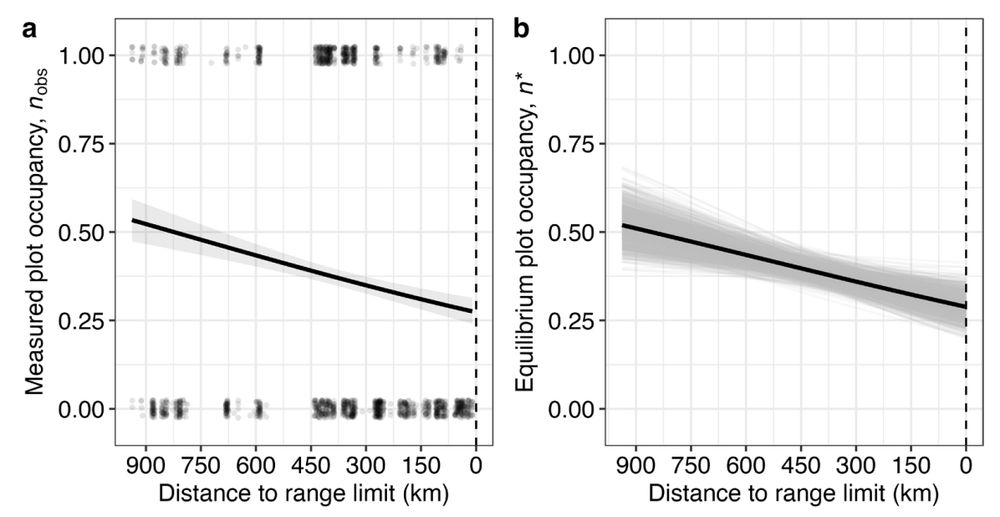
Lastly, we found measured occupancy of plots declined towards the range limit - as we would expect (left). Further, this decline in occupancy is closely matched by the decline predicted by incorporating our estimated rates of colonization and extinction into a metapopulation model (right). (8/9)
06.05.2025 12:31 — 👍 0 🔁 0 💬 1 📌 0
Interestingly, each of these variables (suitable plot area, local abundance, and initial plot abundance) each exhibited variation towards the range limit in a manner that is consistent with declining colonization rates/increasing extinction rates. (7/9)
06.05.2025 12:31 — 👍 0 🔁 0 💬 1 📌 0
Extinction, however, was more likely when there was little suitable habitat at the plot and when the initial plot abundance was smaller (in other words, smaller subpopulations were more likely to go extinct). (6/9)
06.05.2025 12:31 — 👍 0 🔁 0 💬 1 📌 0

Second, we found the likelihood of colonization and extinction were predicted by habitat and population structure. Colonization was greater at plots with more suitable habitat and that had greater local abundance (i.e., abundance of nearby plots), possibly due to higher propagule pressure. (5/9)
06.05.2025 12:31 — 👍 0 🔁 0 💬 1 📌 0

First, we found that the likelihood of patch colonization declined substantially towards the species' northern range limit, while extinction of occupied patches increased non-significantly - changes that we might expect from the metapopulation hypothesis for range limits. (4/9)
06.05.2025 12:31 — 👍 0 🔁 0 💬 1 📌 0
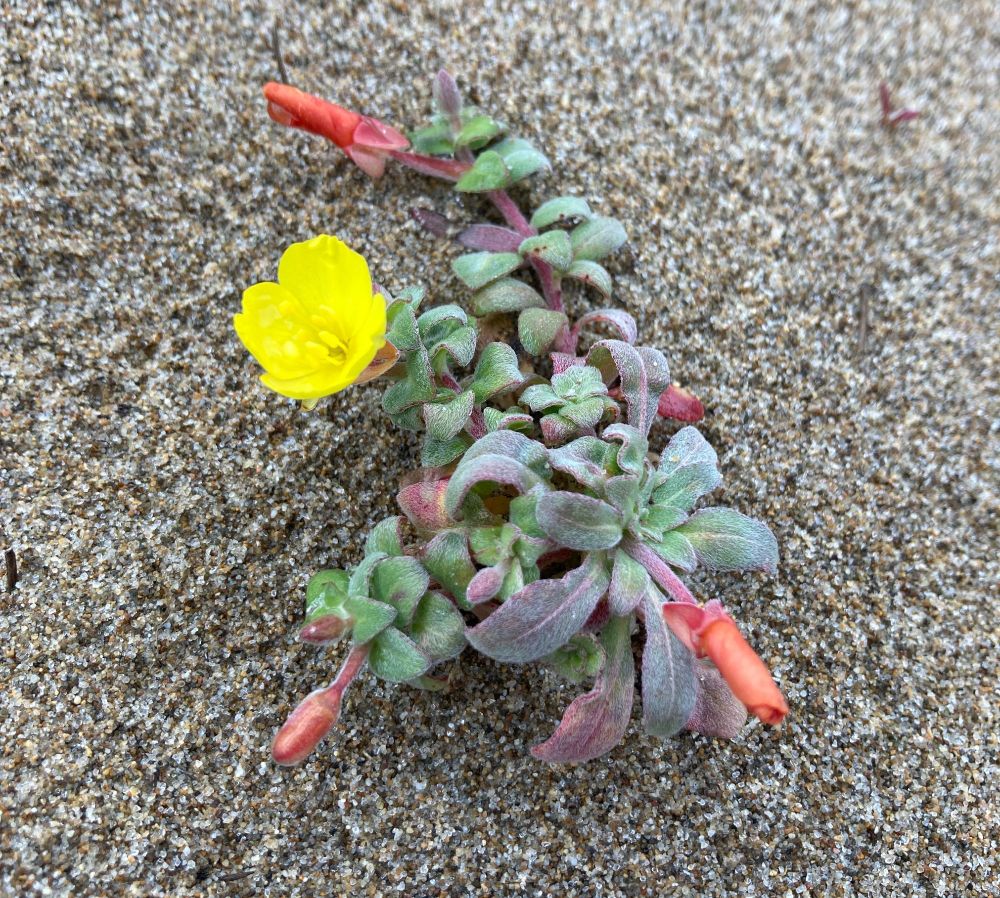
A small plant (Camissoniopsis cheiranthifolia) with fuzzy leaves and a lone yellow flower growing in the sand.

A researcher hiking through the wind-swept coastal dunes in Oregon.
To test this hypothesis, we looked at coastal dune endemic Camissoniopsis cheiranthifolia, and hiked the northern ~900 km of the species' distribution to visit several thousand plots across a multi-year survey. At each, we measured patch occupancy and abundance of this short-lived perennial. (3/9)
06.05.2025 12:31 — 👍 1 🔁 0 💬 1 📌 0
The metapopulation hypothesis posits that a range limit may be imposed by subtle variation in patch dynamics. If colonization of patches declines or extinction from patches increases across space, the metapopulation may collapse, consequently generating an abrupt range limit. (2/9)
06.05.2025 12:31 — 👍 1 🔁 0 💬 1 📌 0

A person standing in front of a research poster.
Yesterday, I presented a poster at MUN’s Biology Symposium, where I chatted about our approach to understanding density-dependent fitness towards elevational range limits. I had a ton of fun, many valuable chats about field methods, and am grateful to have been awarded best poster presentation!
24.04.2025 12:10 — 👍 5 🔁 0 💬 0 📌 0
New Blog post alert 🚨
The photo that got away: Camera traps may monitor less space than we think 📸 🌎 🧪 Read Brendan Carswell's full post here 👇
buff.ly/R9j5xvi
14.03.2025 12:00 — 👍 16 🔁 5 💬 1 📌 0

A small sundew with red leaves that look like they’re covered in water droplets. It is sitting next to a pool of water among some moss
A tiny Florida native sundew for your viewing pleasure. Our native carnivorous plants hold a very special place in my heart ❤️
07.12.2024 02:35 — 👍 82 🔁 10 💬 1 📌 1
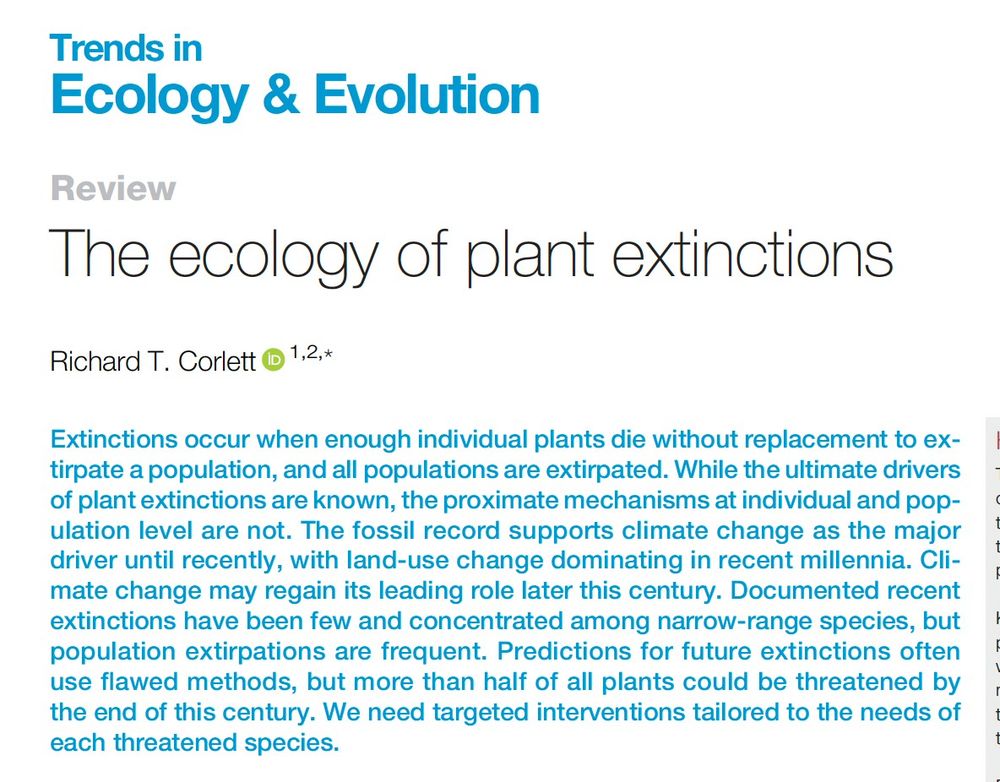
Image of the first page and abstract of the paper "The ecology of plant extinctions
Author links open overlay panel
Richard T. Corlett 1 2
Show more
Add to Mendeley
Share
Cite
https://doi.org/10.1016/j.tree.2024.11.007
Get rights and content
Highlights
The fossil record suggests that climate change was the major driver of plant extinctions and regional extirpations from the Pliocene until recently, when anthropogenic habitat loss became dominant.
Known recent plant extinctions are disproportionately few in comparison with well-studied animal taxa, but many more species are probably committed to inevitable extinction unless given targeted support.
Recent warm-edge extirpations demonstrate the growing impact of anthropogenic climate change and show that predictions of massive climate-driven extinctions later this century are plausible.
The proximate causes for population extirpations are still rarely known but are likely to be highly varied and both species and location specific."
An important review - The ecology of plant extinctions - "Recent warm-edge extirpations demonstrate the growing impact of anthropogenic climate change & show that predictions of massive climate-driven extinctions later this century are plausible" www.sciencedirect.com/science/arti... 🌾🌎🧪🌐
07.12.2024 11:59 — 👍 225 🔁 87 💬 5 📌 0

A snowy valley with sparse vegetation.
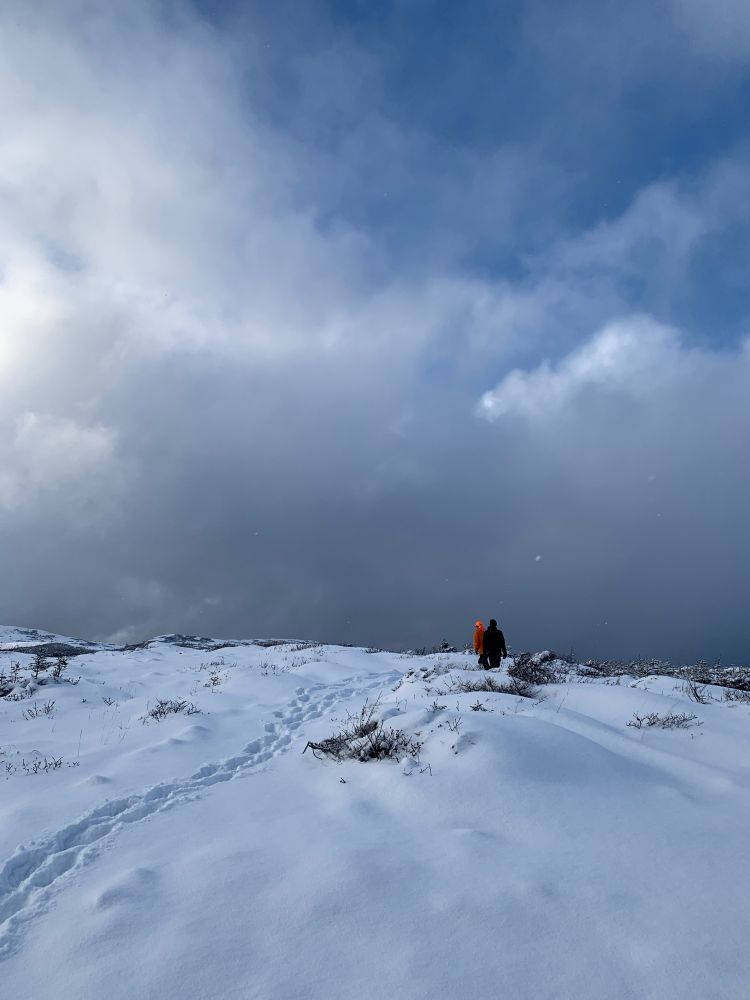
A snowy field with two people in the background.
Spent a couple days this week scouting out potential field sites at Gros Morne National Park. The snow was magical!
07.12.2024 11:59 — 👍 3 🔁 0 💬 0 📌 0
There is still space left in the #biodiversity #redistribution starter pack ⬇️ If you are working on or interested in biodiversity responses, aka #species #range #shifts & #community #composition #changes, to global change drivers, I'd be happy to add you in the list 😀
go.bsky.app/6KqEpb9
07.12.2024 08:41 — 👍 62 🔁 22 💬 38 📌 0
Hi Jonathan! Could you please add me? Thanks!
07.12.2024 11:35 — 👍 1 🔁 0 💬 1 📌 0
I created this stater pack with women in ecology and evolution.
If you want to be added you can comment or DM me, but also please suggest the names of those I am missing 🧪🌎🌐
go.bsky.app/8jFH7cS
30.11.2024 22:51 — 👍 1120 🔁 372 💬 201 📌 11
MEnvSc candidate at University of Toronto 🌱
Interested in species-at-risk conservation, photography, and working at the science-policy interface 🐢 🏳️🌈 https://www.linkedin.com/in/rishona-vemulapalli
https://www.inaturalist.org/observations?user_id=rishonav
By choosing to publish, read & review papers in our journals, you are helping the Royal Entomological Society invest in meaningful entomology that supports the understanding, development & future of insect science.
Follow the RES at @royentsoc.bsky.social
Mexican Historian & Philosopher of Biology • Postdoctoral Fellow at @theramseylab.bsky.social (@clpskuleuven.bsky.social) • Book Reviews Editor for @jgps.bsky.social • #PhilSci #HistSci #philsky • Escribo y edito • https://www.alejandrofabregastejeda.com
We are the British Ecological Society Macroecology & Macroevolution Special Interest Group. We run the annual #BESMacro conference and will gladly repost papers and opportunities of interest to our members!
The Ramsey philosophy of biology lab at KU Leuven, Belgium.
https://www.theramseylab.org • #HPbio #philsci #philsky #evosky #paleosky #cogsci
Ecologist. Assistant Professor at University of Arizona. Global change. Biodiversity, Phenology, Urban Ecology, Phylogeny. https://www.dlilab.com
PhD candidate at Virginia Tech
Global Change | Community Ecology | Species Interactions | Fragmentation | Climate Change | Ants | Seed Dispersal | Plant Ecology
Early career research scientist at Yale, macroecology, quantitative climate change ecology, avian ecology, GIS and species distribution models, scale in ecology.... birder, photographer, human dad, cat dad, baseball fan
Artist, Scientist, Woodland Ecologist, Statistician, Historian & former Research Scholar at the RIA | Art from Dublin, Ireland 🌈 He/Him | Sé/é
Buy my work here: https://robbohan.etsy.com
Ecoclimatology 🌿~ tree-rings 🌳💍 @lamont.columbia.edu @columbiauniversity.bsky.social
NSF PRFB postdoc at Penn State studying adaptation to climate in trees 🌳 #PopUpPoplars | PhD on California oaks | fan of nature and books | she/her
Loving plants, evolution, and plant evolution! 🌿 she/her 🌈
isabeaulewis.github.io
I’m campaigning for more messy spaces for nature, join our messy mission and let’s Rewild together by doing less- and letting nature do the rest!
PhD researcher - Rewilding with Beavers 🦫
Founder of the Wee Pond Project 🐸
Presidential Postdoc at University of Michigan, PhD at Yale | ecosystem ecology | conservation ethics | #caribou, #moose, & other #mammal zoogeochemistry | she/her | #dyslexic misspelled posts mine own
www.kristymferraro.com
PhD candidate studying plant pollinator interactions in urban areas, University of Toronto Mississauga
PhD student at UofT studying how plants evolve in urban environments
Demographer studying species range limits and range dynamics | Asst. Prof. at UBC
SlAVA UKRAINI -Climate-Social Justice-Born at 313 ppm-Colorado gemstone miner, Mt. Antero digger. Nature Writer, OK Boomer. CSU-Pueblo 2015 alum -Stephen J Gould Fan (Natural History).





















